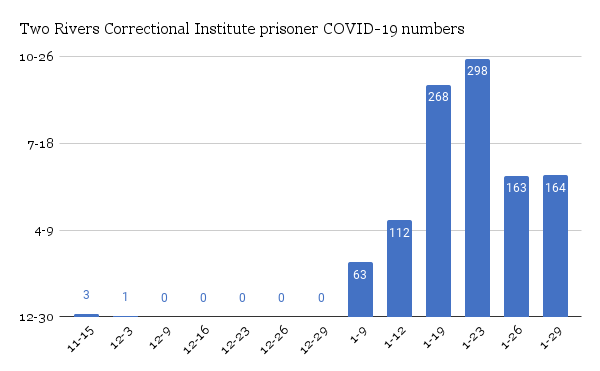Eastern Oregon prisons in quarantine following COVID-19 outbreak
Published 7:00 am Saturday, February 12, 2022

- Case counts for Two Rivers Correctional Institution have spiked over the course of January, peaking at just shy of 300 cases on Jan. 23.
EASTERN OREGON — Eastern Oregon Correctional Institution and Two Rivers Correctional Institution in Umatilla County still are in quarantine due to the spread of the COVID-19 virus throughout their facilities, according to the Department of Corrections COVID-19 tracking website.
Powder River Correctional Facility in Baker County is in a heightened state of alert and testing according to the same tracker, as cases rose amongst the staff and prisoner population at the end of January. Seven out of the 15 prisons in Oregon were in Tier 4 status as of Feb. 8 — meaning that those facilities are under quarantine.
Overall, case numbers had increased dramatically through January, peaking at 286 active cases for Two Rivers on Jan. 20. In December, those numbers were in the single digits.
Those case numbers fell throughout the week. As of Feb. 8, Two Rivers had just one active case of COVID-19, though it still remained in tier 4 status.
As a percentage of total cases during the entire pandemic against the number of beds at each facility, Two Rivers ranked the highest by a wide margin. The case-to-bed rate was at 64.18%, while the average across all prisons in Oregon was 31.81%
Corrections officials wouldn’t say whether or not the COVID-19 cases that spurred a large spike at Two Rivers were due to a staff member, but case numbers and dates shared with EO Media Group show staff at Two Rivers had tested positive on Dec. 29, just 10 days before members of the prison population showed a spike in positive tests.
“There is no way of knowing exactly how each positive case originates or is spread,” said Betty Bernt, communications manager for the Oregon Department of Corrections. “When an individual comes into our intake unit, our current process is to test all adults in custody.”
Juan Chavez, project director and attorney with the Oregon Justice Resource Center, disagrees.
“There’s only one way for the virus to get in, and that’s through the staff,” he said. “It’s abundantly clear that mask wearing has been scant in particular with correctional officers. They haven’t been enforcing the mask wearing policy, they just let it slide. They’re more afraid of losing staff than they are of killing people, in my mind.”
Chavez noted because intake goes through Coffee Creek Correctional Facility — DOC’s intake facility in Wilsonville where adults in custody are tested, isolated and quarantined before being transferred to other parts of the state — the possibility of an inmate bringing the virus into a different prison is remote.
The Oregon Justice Resource Center is involved in a class action lawsuit against the Department of Corrections due to conditions at the prisons regarding COVID-19 safety. That lawsuit is expected to go before a judge for certification on Feb. 14.
Chavez said the lawsuit, filed in April 2020, asked only the bare minimum from the Department of Corrections regarding safety procedures in combating the spread of COVID-19. Those measures included mandatory masking for correctional officers and implementing social distancing requirements.
Those requirements, according to the lawsuit, were widely ignored.
In the lawsuit, one plaintiff described an interaction with staff that conveyed DOC’s reactionary nature to outbreaks: “I was complaining that it was hypocritical we had to wear masks but officers didn’t; that officer said to me ‘(expletive) it, we’ll deal with it when it comes.’”
The lawsuit also described practices where correctional officers would move from a quarantined unit to an uninfected unit without a mask, likely due to overtime and staffing shortages at the facilities.
“I think the (COVID-19) situation shakes the entire foundation,” Chavez said. “What we were asking for only sounds extraordinary if we weren’t in extraordinary times, and so we needed something grander. And that didn’t happen. A lot of people got hurt.”
Two Rivers has been especially problematic, according to prison attorney Tara Herivel, who has litigated hundreds of cases against the Department of Corrections. Herivel said approximately 80% of her cases are against Two Rivers. According to Herivel, despite the litigation and sea of lawsuits, Two Rivers in particular is “not afraid enough to change.”
“The conversation I have a lot with my clients and people I work with is why?” Harivel said. “Why is it so horrible? Why don’t they learn? They’ve been sued so many times, and I just don’t think they’ve been sued enough. I think they don’t have real consequences, and they can brush away these individual suits like the kinds I do pretty easily. They just don’t follow court orders.”
Herivel said in addition to filing a majority of her prison cases against Two Rivers, she has had contempt of court motions against the prison’s medical department for failing to follow the court’s orders, leading to the release of an adult in custody 11 years ago.
Positive cases in staff members at Eastern Oregon prisons — including EOCI, Two Rivers, Snake River Correctional Institution and Powder River — preceded every spike of COVID-19 among the adult population in January.
The correctional facilities handle medical cases through their own health care settings, according to Bernt.
In Ontario, Dr. Garth Gullick, the chief medical officer for the Snake River Correctional Institution, testified that a fever was not a symptom of COVID-19, that COVID-19 testing was “harmful” and said that it “can be the enemy,” according to reporting from the Malheur Enterprise. The reporting also indicated that Dr. Warren Roberts, Corrections’ top medical adviser, had been ordered to stop performing surgeries and had a history of malpractice.
“Cases are handled internally to the extent possible through our Health Services units and infirmaries,” Bernt said. “If an individual’s symptoms surpass our ability to care for them, they are transferred to a hospital for care.”
A spokesperson for Two Rivers declined to comment on the COVID-19 outbreak at the facility, citing a need to go through the Oregon Department of Corrections for a unified response.
EOCI saw a milder outbreak than it had at the start of the pandemic, according to supervising executive assistant Ron Miles.
“In addition to masking, we’ve done our best ability to maintain social distance or maintain 6 feet of distance between everybody, but the challenge with that is putting 1,700 people into a 15.2-acre location,” he said. “So social distancing is not going to be easy; that’s just a fact of prison life.”
EOCI saw one case among its staff on Dec. 23, 2021, according to the DOC data. Six days later, the facility saw its first cases among its adults in custody population, before it peaked at 47 positive cases among the adults in custody and nine cases among the staff on Jan. 12. In October 2020, EOCI had more than 350 active cases.
As of Feb. 8, EOCI had zero active COVID-19 cases, according to the DOC COVID-19 website.
Powder River, in Baker City, saw a small outbreak of 21 cases by Jan. 29, which fell to eight cases on Feb. 8. Herivel said that Powder River was one of the best prisons in Eastern Oregon when it came to COVID safety.
On the other hand, Two Rivers had nearly 15% of its adult population test positive for the COVID-19 virus on Jan. 23.
Miles said EOCI offers vaccines to the adult in custody population, as well as offering vaccine booster clinics from time to time for prisoners to keep up to date with the COVID-19 vaccines.
Previous reporting by the East Oregonian through numerous interviews with lawyers representing clients at Two Rivers, as well as inmates themselves, had shown a lax regard for COVID-19 safety at Two Rivers. Inmates cited improper mask wearing by staff members and mixing of COVID-19-positive inmates with the general population for work.
According to previous reporting by Oregon Public Broadcasting, Two Rivers saw a spike in infections during December 2020 after two staff members tested positive, and the facility transferred 10 positive individuals from Deer Ridge Correctional Institution, Madras. The same day the facility transferred adults in custody from Deer Ridge, it began seeing a spike in cases, with 85 cases on Dec. 21, 2020.
As of Feb. 8, 10 employees at Two Rivers had not yet stated either their vaccination or exemption status. Powder River had just two, and EOCI had six. Out of the 5,306 DOC employees reported to have been under the vaccination compliance executive order in 2021, nearly 20% had filed and received a medical or religious exemption, according to DOC data from October 2021.
The number of in-custody deaths across the state also appears to be increasing, with four reported deaths within a five-day period between Jan. 27 and Jan. 31. Since the start of the pandemic, 45 adults in custody have died after testing positive for COVID-19, according to DOC data, while 17 of those deaths are from adults in custody at Two Rivers, the highest out of all prisons in Oregon, despite being the third-largest prison in Oregon. EOCI, which has a similar population size of adults in custody, saw four deaths throughout the pandemic, while PRCF saw none.
The Department of Corrections keeps a spreadsheet of positive tests for COVID-19 on its website, but that database has not been updated since Nov. 12. Officials with the DOC said staffing issues and the tediousness of entering the data by hand had made the task too resource-intensive. Daily COVID-19 statistics and current active cases can be found on the Department of Corrections website through their COVID-19 tracker at www.oregon.gov/doc/covid19/Pages/covid19-tracking.aspx.





